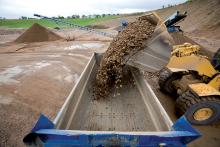
Reversing is a hazardous process in a quarry site but, according to Brigade, there is a quieter alternative to noise pollution creating beeping systems
Beeping reversing alarms are now commonly heard in quarry sites across Europe as operators try to reduce the risk of strike accidents during manoeuvring operations. But while such systems can improve safety, the noise they create can be difficult to locate and may also be a nuisance to neighbours.
However, UK-based
Brigade CEO and chairman Christopher Hanson Abbott first introduced tonal reversing alarms first to the UK and then Europe after seeing such systems in Japan. "Tonal reversing alarms were first used in Japan in the 1960s and having seen the safety benefits during a visit in the mid 1970s, I started to introduce them to the UK market," he said. "Quarry operators were among my first customers because they could see a real safety advantage of having an audible reversing warning system." But the tonal systems present several problems which limits their effectiveness and causes irritation. The type of noise and volume needed means that it is reflected easily so can be heard over a wide area - often outside the hazard area - and also makes it difficult to locate the source. Overexposure to such alarms tends to make people blasè about them and start ignoring them.
Hanson Abbott was aware of the problems and came across some research by Professor Whittington from
"The BBS-tek alarm uses broadband multi-frequency sound instead of the traditional narrowband frequency of tonal alarms," explained Hanson Abbott. "The broadband system has a frequency range spanning 500 to 7000Hz, whereas a conventional tonal alarm usually operates at around 12,000Hz. This gives the broadband its distinctive shh shh shh sound rather than the conventional beep beep beep from a tonal system.
"The volume of the alarm is a function of the frequency and sound pressure measured in decibels. Because of the multi-frequency, the broadband alarm can operate at a lower sound pressure which means the sound does not carry as far as a tonal system. Broadband often operates at 5dB(A) less than a tonal alarm to achieve the same volume but does need a higher quality speaker to achieve the effect.
"The range of frequency also means that it is better for the partially deaf as they usually have good hearing in some frequencies and can often hear some part of the broadband range." The costs of investing in a BBS-tek alarm are 50% higher than a tonal alarm but at £100 (€125) for a system suitable for an articulated dump truck, the investment is not significant. According to Hanson Abbott, retro-fitting is not complicated and can be completed very quickly. "If the vehicle is fitted with an existing alarm or a reversing light, then is can take just 10minutes to fit a broadband frequency system," he said.










